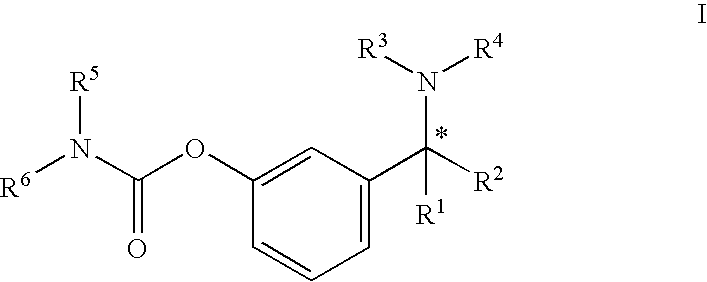Process for the preparation of phenylcarbamates
a technology carbamate, which is applied in the field of process for the preparation of aminoalkyl phenyl carbamate compounds, can solve the problems of hazardous handling of isocyanates such as lower alkyl isocyanates, difficult industrial handling of carbamoyl halides, and hazardous use of reactive bases like sodium hydride on an industrial scale. hazardous and unusable problems
- Summary
- Abstract
- Description
- Claims
- Application Information
AI Technical Summary
Benefits of technology
Problems solved by technology
Method used
Image
Examples
example 1
[0029]A solution of 3-[1-(dimethylamino)ethyl]phenol (0.41 g, 2.5 mmoL) and triethylamine (0.8 g, 7.9 mmoL) in dichloromethane (10 mL) was stirred under nitrogen and cooled using an ice-bath. 1-Chloroethyl chloroformate (0.43 g, 3 mmoL) was added to the solution and the mixture was stirred for 1 h whereupon N-ethylmethylamine (0.24 g, 4 mmoL) was added and the solution was allowed to warm slowly to room temperature and stirred overnight. The reaction mixture was quenched by the addition of water (10 mL) and the pH of the aqueous layer was adjusted to >10 by the addition of aqueous NaOH solution. The organic layer was separated and the aqueous layer was extracted with additional dichloromethane. The combined organic extracts were washed with water and evaporated to dryness. The residue was dissolved in diethyl ether and extracted with dilute HCl solution. The pH of the aqueous solution was adjusted to >10 by the addition of aqueous NaOH solution and extracted with diethyl ether. The ...
example 2
[0030]A solution of 3-[1-(dimethylamino)ethyl]phenol (0.41 g, 2.5 mmoL) and triethylamine (0.8 g, 7.9 mmoL) in dichloromethane (10 mL) was stirred under nitrogen and cooled using an ice-bath. 4-Nitrophenyl chloroformate (0.6 g, 3 mmoL) was added to the solution and the mixture was stirred for 1 h whereupon N-ethylmethylamine (0.24 g, 4 mmoL) was added and the solution was allowed to warm slowly to room temperature and stirred overnight. The reaction mixture was quenched by the addition of water (10 mL) and the pH of the aqueous layer was adjusted to >10 by the addition of aqueous NaOH solution. The organic layer was separated and the aqueous layer was extracted with additional dichloromethane. The combined extracts were washed with water and evaporated to dryness. The residue was dissolved in diethyl ether and extracted with dilute HCl solution. The pH of the aqueous solution was adjusted to >10 by the addition of aqueous NaOH and extracted with diethyl ether. The ethereal layers we...
example 3
[0031]A mixture of 3-[1-(dimethylamino)ethyl]phenol (0.82 g, 5 mmoL) in acetonitrile (5 mL) was stirred under nitrogen and cooled using an ice-bath. 1,1′-Carbonyldiimidazole (1.0 g, 6 mmoL) was added and the resulting solution was stirred at room temperature for 1.5 h. The solution was re-cooled using an ice-bath and acetic acid (1.0 g, 16.7 mmoL) was added followed by N-ethylmethylamine (0.5 g, 8.3 mmoL). The solution was allowed to warm slowly to room temperature and stirred for 3 hours. The reaction mixture was evaporated and the residue was dissolved in diethyl ether (20 mL). Water (10 mL) was added to the solution and the pH of the aqueous layer was adjusted to >10 by the addition of aqueous NaOH. The organic layer was separated and the aqueous layer was extracted with diethyl ether. The combined organic extracts were washed with water and evaporated to dryness to give racemic Rivastigime (0.8 g) as a liquid.
PUM
| Property | Measurement | Unit |
|---|---|---|
| temperature | aaaaa | aaaaa |
| temperature | aaaaa | aaaaa |
| reaction temperature | aaaaa | aaaaa |
Abstract
Description
Claims
Application Information
 Login to View More
Login to View More - R&D
- Intellectual Property
- Life Sciences
- Materials
- Tech Scout
- Unparalleled Data Quality
- Higher Quality Content
- 60% Fewer Hallucinations
Browse by: Latest US Patents, China's latest patents, Technical Efficacy Thesaurus, Application Domain, Technology Topic, Popular Technical Reports.
© 2025 PatSnap. All rights reserved.Legal|Privacy policy|Modern Slavery Act Transparency Statement|Sitemap|About US| Contact US: help@patsnap.com



